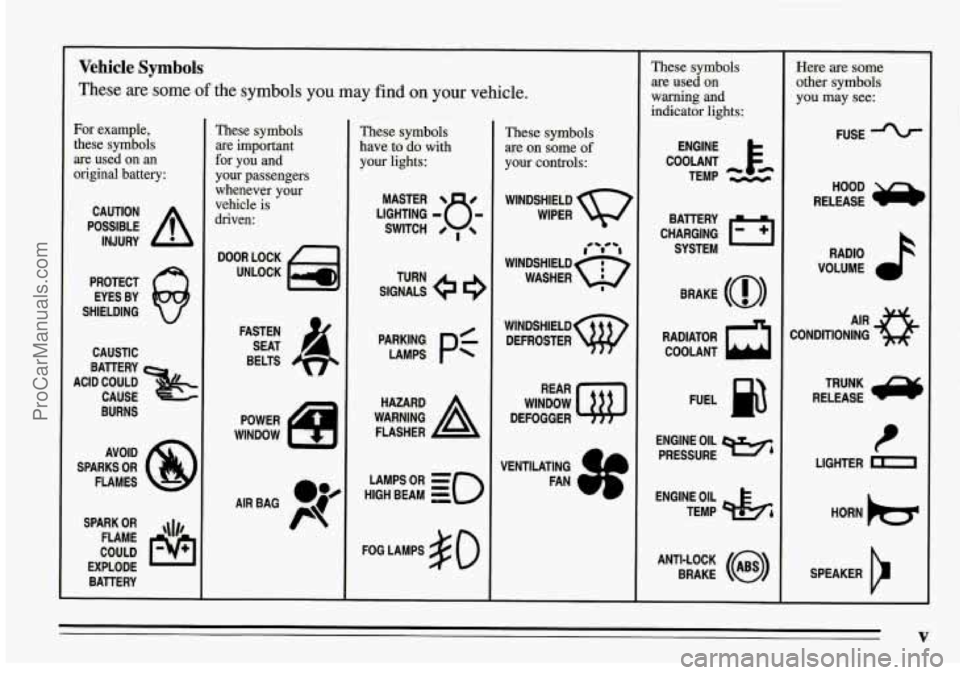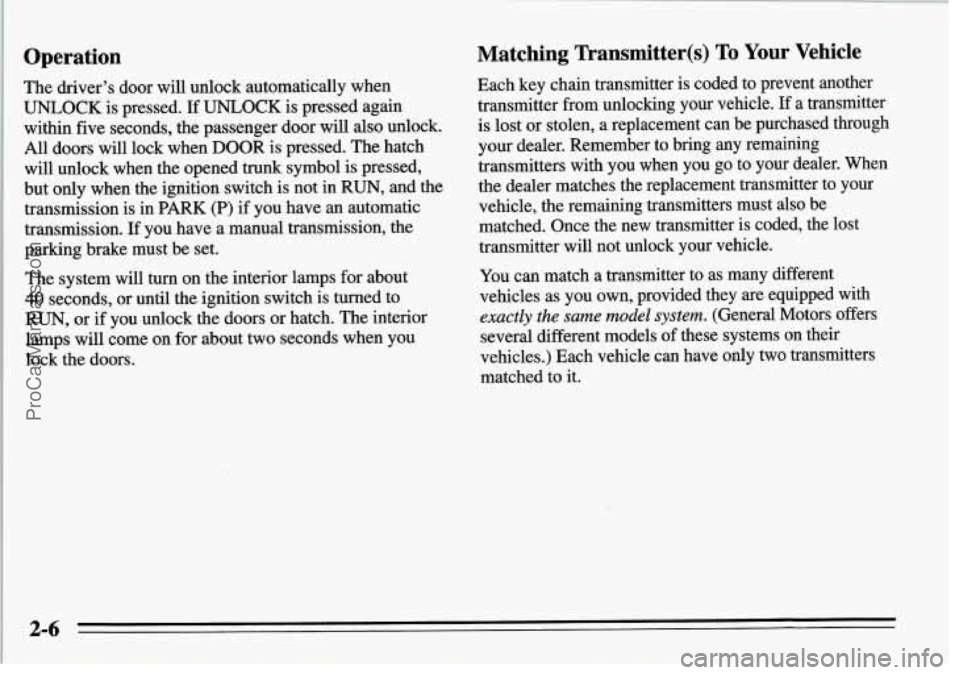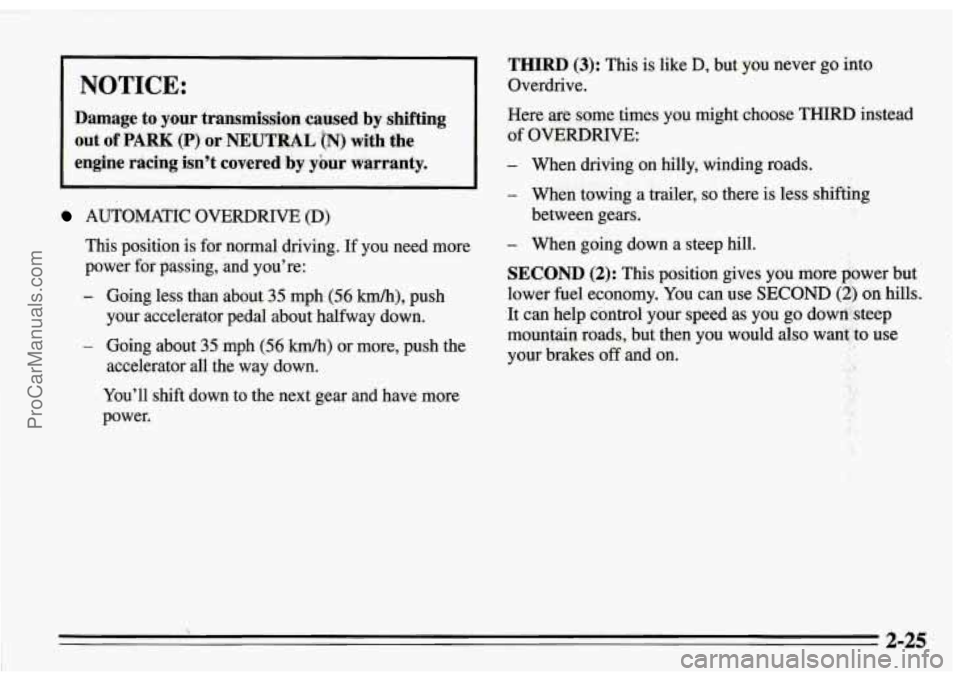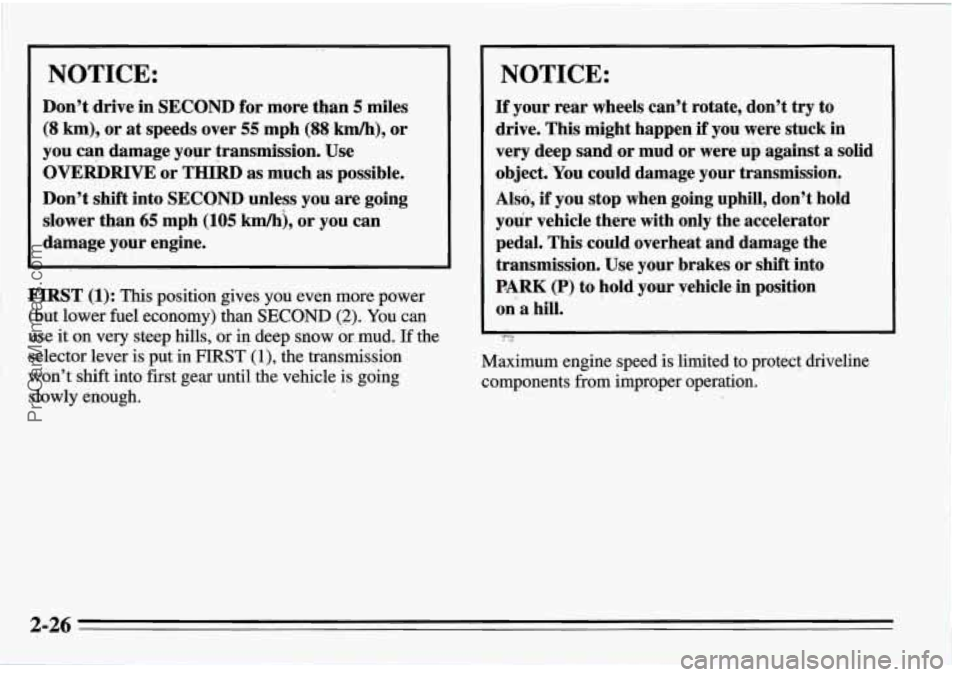brake PONTIAC FIREBIRD 1995 Owners Manual
[x] Cancel search | Manufacturer: PONTIAC, Model Year: 1995, Model line: FIREBIRD, Model: PONTIAC FIREBIRD 1995Pages: 386, PDF Size: 19.66 MB
Page 6 of 386

Vehicle Symbols
These are some of the symbols you may find on your vehicle.
For example, these symbols
are used on an
original battery:
POSSIBLE A
CAUTION
INJURY
PROTECT EYES BY
SHIELDING
CAUSTIC
BURNS
AVOID
SPARKS
OR
FLAMES
SPARK OR ,\I/,
COULD FLAME
EXPLODE BAllERY
These symbols
are important
for you and
your passengers
whenever your
vehicle is
driven:
FASTEN SEAT 4
BELTS
POWER
WINDOW
These symbols
have to
do with
your lights:
SIGNALS e
TURN
pAE: pf
HIGH LAMPSoR BEAM = =o
FOG LAMPS $0
These symbols are on some
of
your controls:
WINDSHIELD
WIPER
i ‘t’ i
WINDSHIELD Q
WASHER I
WINDSHIELD
DEFROSTER
WINDOW
DEFOGGER
VENTILATING FAN
These symbols
are used on
warning and
indicator lights:
COOLANT F*
TEMP --
ENGINE
CHARGING 1-1
BATTERY
SYSTEM
BRAKE (0)
RADIATOR COOLANT
a
FUEL
ENGINE OIL
PRESSURE
9%
TEMP OIL &
ANTI-LOCK (a)
BRAKE
-
Here are some
other symbols
you may see:
FUSE
RAM0 h
VOLUME
CONDITIONING AIR 43
RELEASE a
LIGHTER m
SPEAKER
b
V
ProCarManuals.com
Page 53 of 386

Operation
The driver’s door will unlock automatically when
UNLOCK is pressed. If UNLOCK is pressed again
within five seconds, the passenger door will
also unlock.
All doors will lock when DOOR is pressed. The hatch
will unlock when the opened
trunk symbol is pressed,
but only when the ignition switch is not in
RUN, and the
transmission is in
PARK (P) if you have an automatic
transmission.
If you have a manual transmission, the
parking brake must be set.
The system will turn on the interior lamps for about
40 seconds, or until the ignition switch is turned to
RUN,
or if you unlock the doors or hatch. The interior
lamps will come on for about two seconds when you
lock the doors.
Matching Transmitter(s) To Your Vehicle
Each key chain transmitter is coded to prevent another
transmitter from unlocking your vehicle.
If a transmitter
is lost or stolen, a replacement can be purchased through
your dealer. Remember to bring any remaining
transmitters with you when you
go to your dealer. When
the dealer matches the replacement transmitter to your
vehicle, the remaining transmitters must also be
matched. Once the new transmitter is coded, the lost
transmitter
will not unlock your vehicle.
You can match a transmitter to as many different
vehicles as you own, provided they are equipped with
exactly the same model system. (General Motors offers
several different models of these systems on their
vehicles.) Each vehicle can have only two transmitters
matched to
it.
2-6
ProCarManuals.com
Page 57 of 386

Remote Hatch Release (Option)
...
, .:
, .. .... . <. ,.
, . . 1.1 1;, The switch only works when the ignition switch is in
. 2''. kUN or ACC, or when RAP is present. (See "Retained
Press the svitch under the lamp controls to unlock the .; .;:. :. - .
hatch from hide your vehicle. If you have an automatic . :;:: .. ''i.
trahrhission, your shift lever must be in PARK (P) or
NEUTRqL (N) to use the switch. If you have a manual .... ...
transn&on and the ignition switch is in RUN, you . .,
must sit [email protected] brake befor9 you.:can use the .. .,:,,. ... ...... .. :! ..
.. ,. .I - , ~ , , _L . j,' ,. ,-' ' , . ' .' .i: .: .I ,~. .:.: :. .
c
ProCarManuals.com
Page 61 of 386

New Vehicle “Break-In” Ignition Switch
NOTICE:
Your modern Pontiac doesn’t need an elaborate
%break-in.” But it
will perform better in the long
run
if you follow these guidelines:
0
0
0
0
Keep your speed at 55 mph (88 km@) or
less for the first
500 miles (804 km).
Don’t drive at any one speed
-- fast or slow
-- for the first 500 miles (804 km). Don’t
make full-throttle starts.
Ayoid making hard stops for the first
2a0: miles (322 kni) or so. During this time
your new brake linings aren’t yet broken
in. Hard stops with new linings can mean
premature wear and earlier replacement.
Follow this “breaking-in” guideline every
time you get new brake linings.
Don’t tow a trailer during “break-in.” See
“Towing a Trailer” in the Index for more
information.
With the ignition key in the ignition switch, you can turn
the switch to five positions:
ACC (A): Position in which you can operate your
electrical power accessories. Press in the ignition switch as you
turn the top of it toward you.
LOCK (B): The only position in which you can remove
the key. This locks your steering wheel, ignition and
automatic transmission.
2-14
ProCarManuals.com
Page 71 of 386

Ensure the shift lever is fully in PARK (P) range
before starting the engine. Your Pontiac has a
brake-transmission shift interlock. You have to fully
apply your regular brakes before you can shift from
PARK (P) when the ignition key is in the RUN position.
If you cannot shift out of PARK (P), ease pressure on
the shift lever
-- push the shift lever all the way into
PARK
(P) and also release the shift lever button on floor
shift console models
as you maintain brake application.
Then move the shift lever into the gear you wish. (Press
the shift lever button before moving the shift lever on
floor shift console models.) See “Shifting Out of
PARK (P) in
this part.
REVERSE (R): Use this gear to back up.
NOTICE:
Shifting to REVERSE (R) while your vehicle is
moving forward could damage your transmission. Shift to REVERSE
(R) only after
your vehicle is stopped.
To rock your vehicle back and forth to get out of snow,
ice or sand without damaging your transmission, see
“Stuck:
In Sand, Mud, Ice or Snow, If You’re” in the
Index.
NEUTRAL (N): In this position, your engine doesn’t
connect with the wheels.
To restart when you’re
already moving, use NEUTRAL
(N) only. Also, use
NEUTRAL,
(N) when your vehicle is being towed.
ProCarManuals.com
Page 72 of 386

NOTICE:
THIRD (3): This is like D, but you never go into
Overdrive.
Damage to your transmission caused by shifting Here are some times you might choose THIRD instead
out of PARK (P) or NEUTRAL [N) with the of OVERDRIVE:
engine racing isn’t covered by your warranty. - When driving on hilly, winding roads.
- When towing a trailer, so there is less shifting
AUTOMATIC OVERDWE (D) between gears.
This position is for normal driving. If you need more
power for passing,
and you’re:
- Going less than about 35 mph (56 kmk), push
your accelerator pedal about halfway down.
- Going about 35 mph (56 kmk) or more, push the
accelerator all the way down.
You’ll shift down to the next gear and have more
power.
- When going down a steep hill.
SECOND (2): This position gives you more power but
lower fuel economy.
You can use SECOND (2) on hills.
It can help control your speed as you go dowri-:.steep
mountain roads, but then you would also want-to use
’,
your brakes off and on.
4
!
1
I
ProCarManuals.com
Page 73 of 386

NOTICE:
Don’t drive in SECOND for more than 5 miles
(8 km), or at speeds over 55 mph (88 km/h), or
you can damage your transmission. Use
OVERDRIVE or
THIRD as much as possible.
Don’t shift into SECOND unless you are going
slower than
65 mph (105 km/h), or you can
damage’your engine.
FIRST (1): This position gives you even more power
(but lower fuel economy) than
SECOND (2). You can
use it
on very steep hills, or in deep snow or. mud. If the
selector lever is put
in FIRST (l), the transmission
won’t shift into
first gear until the vehicle is going
slowly enough.
NOTICE:
If your rear wheels can’t rotate, don’t try to
drive.
This might happen if you were stuck in
very deep sand
or mud or were up against a solid
object.’
You could damage your transmission.
Also, if you stop when going uphill, don’t hold
your vehicle there with only the acceleratw
pedal.
This could overheat and damage the
transmission.
Use your brakes or shift into
BARK (P) to hold your vehicle in position
on.‘
a hill.
.- e 1Y .,
Maximum engine speed is limited to protect driveline
Lomponents from improper operation.
2-26
ProCarManuals.com
Page 75 of 386

0 To Stop: Let up on the accelerator pedal and press
the brake pedal. Just before the vehicle stops, press
the clutch pedal and the brake pedal, and shift to
NEUTRAL.
NEUTRAL (N): Use this position when you start or
idle your engine.
REVERSE (R): To back up, press down the clutch
pedal
and shift ipto REVERSE (R). Let up on the
clutch pedal slowly while pressing the accelerator
pedal.
F
NOTICE:
Shift to REVERSE (R) only after your vehicle is
stopped. Shifting to REVERSE
(R) while your
vehicle is moving could damage your
transmission.
Also, use Reverse, along with the parking brake, for
parking your vehicle.
I
2-28
Six-Speed
3 5 R
2 4 6
This is your shift pattern. Here’s how to operate your
transmission:
FIRST (1): Press the clutch pedal and shift into
FIRST (1). Then, slowly let up on the clutch pedal as
you press the accelerator pedal.
ProCarManuals.com
Page 76 of 386

You can shift into FIRST (1) when you’re going less
than
20 mph (32 kmk). If you’ve come to a
complete stop and it’s hard to shift into FIRST
(1)
put the shift lever in NEUTRAL and let up on the
clutch. Press the clutch pedal back down. Then shift
into FIRST
(1).
0 SECOND (2): Press the clutch pedal as you let up
on the accelerator pedal and shift into SECOND (2).
Then, slowly let up on the clutch pedal as you press
the accelerator pedal.
THIRD, FOURTH, FIFTH, and SIXTH (3,4,5,
and 6 Gears): Shift into THIRD (3), FOURTH (4),
FIFTH (5) and SIXTH (6) the same way you do for
SECOND (2). Slowly let up on the clutch pedal as
you press the accelerator pedal.
0 To Stop: Let up on the accelerator pedal and press
the brake pedal. Just before the vehicle stops, press
the clutch pedal and the brake pedal, and shift
to“Neutra1.”
0
0
NEUTRAL (N): Use this position when you start or
idle your engine.
REVERSE (R): To back up, press down the clutch
pedal and shift into REVERSE (R). Let up on the
clutch pedal slowly while pressing the accelerator
pedal. If you
shift from SIXTH (6) into REVERSE
(R) the shift lever must be first placed in the
NEUTRAL position centered between SECOND
(2)
and THIRD (3) prior to shfting into REVERSE (R).
Your six-speed manual transmission has a feature that
allows you to safely shift into REVERSE (R) while the
vehicle is rolling (at less than
5 mph). You will be
locked-out if you try to shift into REVERSE (FQ while
your vehicle is moving faster than
5 mph.
If you have turned your ignition off and wish to park
your vehicle
in Reverse, you will have to move the shift
lever quickly to the right, “crashing” through the high
load spring and then into gear.
I
/ I
I I 2-29
f
1
ProCarManuals.com
Page 79 of 386

Limited-Slip Rear Axle
If you have this feature, your rear axle can give you
additional traction on snow, mud, ice, sand or gravel. It
works like a standard axle most
of the time, but when
one of the rear wheels has no traction and the other does,
the limited-slip feature
will allow the wheel with
traction to move the vehicle.
Parking Brake
The parking brake uses the brakes on the rear wheels.
To set the parking brake:
Hold the brake pedal down and pull up on the parking
brake lever.
If the ignition is on, the brake system
warning light
will come on.
ProCarManuals.com